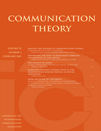Top Qs
Timeline
Chat
Perspective
Communication Theory (journal)
Academic journal From Wikipedia, the free encyclopedia
Remove ads
Communication Theory is a quarterly peer-reviewed academic journal publishing research articles, theoretical essays, and reviews on topics of broad theoretical interest from across the range of communication studies. It was established in 1991 and the current editor-in-chief is Thomas Hanitzsch (University of Munich). According to the Journal Citation Reports, the journal has a 2014 impact factor of 1.667, ranking it 13th out of 76 journals in the category "Communication".[1] It is published by Wiley-Blackwell on behalf of the International Communication Association.
Communication theories are frameworks used by scholars and practitioners to understand and predict how information is conveyed, interpreted, and understood. They explore basic elements of communication, from interpersonal conversations to mass media messaging, and provide insights into message crafting, technology influence, and media priorities.[2]
Remove ads
Editors
The following persons have been editor-in-chief of the journal:
- 2012–present: Thomas Hanitzsch (University of Munich)
- 2009–2011: Angharad N. Valdivia (University of Illinois at Urbana–Champaign)
- 2006–2008: Francois Cooren (Université de Montréal)
- 2003–2005: Chris Segrin (University of Arizona)
- 2003: Scott Jacobs (University of Illinois)
- 2000–2002: Michael J. Cody (University of Southern California)
- 1997–1999: James A. Anderson (University of Utah)
- 1994–1996: Don Ellis (University of Hartford)
- 1991–1993: Robert T. Craig (University of Colorado at Boulder)
Remove ads
References
External links
Wikiwand - on
Seamless Wikipedia browsing. On steroids.
Remove ads

